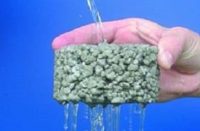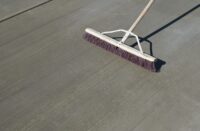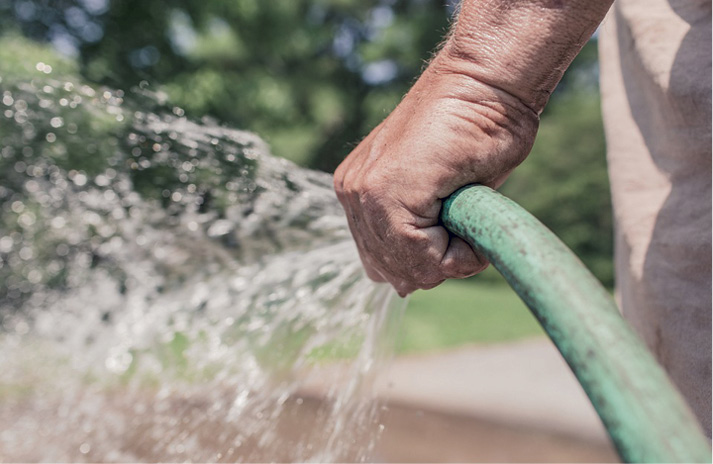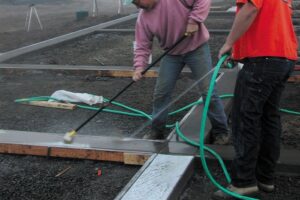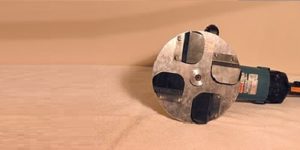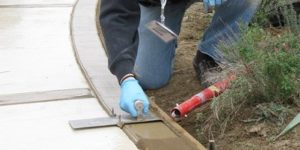With spring here and summer fast approaching, I feel inclined to address an issue which, unfortunately, I see all too often — weakened, flaking, cracking and discolored concrete. These conditions can be almost always traced back to improper finishing practices and the improper use of water during concrete’s finishing stage.
There have been articles, specifications and tests that have all shed light on the improper use of water during the finishing stage. It’s clear that adding even a little bit of water can change the water-to-cement (w/c) ratio at the surface of the concrete and promote shrinkage, discoloration, cracking, a weakened surface and, eventually, scaling or flaking.
All of this can be averted by following proper finishing protocols and avoiding the use of water while finishing concrete. I’ve witnessed firsthand the “blessing” of a slab — sprinkling water on the surface and working it in — to close the surface or make the concrete more workable. While this may seem like your only option in saving a slab, think again. There are other options available.
Evaporation retardants (good)
More than a generation ago, the industry developed evaporation retardants to eliminate using water during the finishing process. The result was better concrete, less cracking and scaling, and a reduction in the number of “tear outs.”
The premise of evaporation retardants was simple — they extend the effective working time of the concrete while in its plastic state by slowing down the rate of evaporation of the bleed water at the surface. The chemistry is straightforward as well, nine parts of water to one-part proprietary chemical blend.
Per the written instructions of an industry leader’s evaporation retardant: Apply to concrete immediately after screeding. Apply with a low-pressure sprayer using constant pressure. Apply uniformly and cover the surface with a fine mist.
An evaporation retardant works by forming a monomolecular-single molecule film across the entire surface of the treated concrete. It is hydrophobic, meaning the water within the concrete is held in place until such time that the film evaporates and the bleed water breaks through the surface. This allows contractors additional time to complete the placement of the concrete before falling back to begin the finishing process.
Evaporation retardants are ideal for use in hot, dry or windy conditions where rapid moisture loss at the concrete surface wreaks havoc on placing and finishing concrete properly. It causes the concrete to crust over, crack or become unworkable.
Most manufacturers of evaporation retardants also state something to this effect: Do not work into surface. Or, evaporation retardant is not a finishing aid. What does this last statement mean? It means that the evaporation retardant isn’t meant to be used during the troweling process of the concrete. It shouldn’t be “worked into” the concrete.
A generation or more ago this was not an issue. However, in today’s need-it bigger, better and faster society in which we live, concrete is being placed in larger and larger pours without much thought given to proper placement and finishing. Thus, evaporation retardants are being misused, with results similar to that of using water. Instead of being used as intended or designed, they’re being used as finishing aids.
Evaporation retardants are being troweled directly into the concrete. Once that monomolecular film is broken, it’s the same as adding nine parts of water directly to the concrete slab. There’s no difference and you have effectively changed the w/c ratio.
The result for the concrete finisher is immediate. The concrete becomes more workable. However, the result to the finished concrete can be very detrimental by creating a weakened surface, susceptible to cracking, crazing, discoloration, flaking, scaling and dusting in the weeks and months to come.
Colloidal silica finishing aids (best)
What’s that saying: Necessity is the mother of invention?
Once again technology has evolved to the point where true finishing aids have been developed. There are now finishing aids available on the market that use colloidal silica technology. When used according to manufacturer’s written instructions, these finishing aids can increase the window of finishing concrete in hot, dry or windy conditions.
Unlike evaporation retardants, colloidal silica finishing aids are meant to be worked directly into the concrete at any stage of the finishing process. Because the finishing aid is reactive, it chemically reacts with the lime found within the portland cement to create additional workable cementitious material, translating into a more abrasion-resistant and dense surface with improved performance. This results in higher compressive strengths, doesn’t alter the w/c ratio, and tightens the capillaries within the concrete which, in turn, reduces water vapor transmission.
This type of true finishing aid eliminates the need to add water to the surface which can be detrimental to the slab’s surface performance. Further, it’s excellent for use with shake-on floor hardeners in low bleed-water environments.
From the contractors’ point of view, one of the biggest advantages of using colloidal silica finishing aids versus water or evaporation retardants is the fact that they can be used during the final troweling and finish application. Because they lubricate the surface, they help reduce operator fatigue and trowel wear while still providing all the benefits of a harder, abrasion-resistant and dense surface.
While water should never be used during the place-and-finish process, a case can be made for the proper use of evaporation retardants and an even stronger case for colloidal silica finishing aids. Evaporation retardants cost a few cents per square foot and, when used correctly, provide a benefit.
Colloidal silica finishing aids cost a few more cents per square foot than an evaporation retardant and provide additional long-term benefits, as already discussed, in addition to increasing the window of finishability.
Why risk tearing out and replacing your concrete when you can use proven technologies and systems? The key is knowing what to use and how to properly use them.
The goal is to help our industry grow and evolve, using technologies and systems. By working smarter we don’t always have to work harder.

